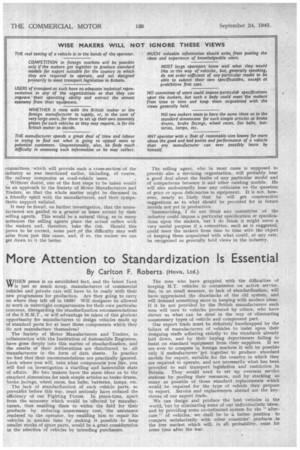More Attention to Standardization Is Essential
Page 32

If you've noticed an error in this article please click here to report it so we can fix it.
By Carlton F. Roberts (Ham, Ltd.) WHEN peace is an established fact, and the latest Tank VI' is just so much scrap, manufacturers of commercial vehicles and private cars will have to be ready with their new programmes for production. Are they going to carry on where they left off in 1939? Will designers be allowed to work in watertight compartments for their own particular concerns, disregarding the standardization recommendations of the S.M.M.T., or will advantage be taken of this glorious . opportunity for manufacturers to design vehicles made up of standard parts for at least those components which they do not manufacture themselves? •
The Society of Motor Manufacturers and Traders, in collaboration with the Institution of Automobile Engineers, have gone deeply into this matter of standardization, and the results of their deliberations are 'distributed to all manufacturers in the form of data sheets. In practice we find that their recommendations are practically ignored. Look where you will, take what components you like, you will find on investigation a startling and lamentable state of affairs. No two makers have the same ideas as to the standard dimensions for such simple articles as brake drums, . brake facings, wheel races, fan belts, batteries, lamps, etc. • The lack of standardization of such -vehicle parts, so prevalent before this war, must seriously have reduced the efficiency of our Fighting Forces. In peace-time, apart from the economy which would be 'effected by manufacturers, thus enabling them to widen the field for their products by reducing unnecessary cost, 'the assistance rendered to the operator, by enabling him to repair his vehicles in quicker time by making it possible to keep smaller stocks of spare parts, would be a great consideration in the selection of vehicles by intending purchasers. The men who have grappled with the difficulties of keeping M.T. vehicles in commission on active service, due, in no small measure, to lack of standardization, will naveappreciated the drawbacks of the old system, and will demand something more in keeping with modern ideas. If it be not provided by the British manufacturers such men will turn to vehicles produced by others, who have shown us what can be dons in the 'way of 'eliminating unnecessary types of vehicle and component part. Our export trade must be definitely handicapped by the failure of manufacturers of vehicles to insist upon their designing staffs adhering strictly to the standards already laid down, and by their buying departments failing to insist on standard equipment from their suppliers. If we are ever to compete in foreign markets it will be possible only if mahufacturers get together to produce standard models for export, suitable for the country in which they are required to operate, and not necessarily what has been provided to suit transport legislation and restriction in Britain. They would need tO set up overseas service stations by pooling their resources, and by stocking as many as possible of those standard replacements which would be required for the type of vehicle they propose to export. Service and replacements abroad are the keystones of our export' trade.
We can design' and produce the best vehicles in the world, but by eliminating some of our individualistic ideas, and by providing some co-ordinated system for the "after care of vehicles, we shall be in a better position to compete. satisfactorily with other countries' products . in the free market which will, in all probability, exist for
some time after the war. .




























































